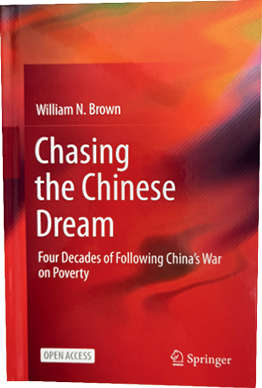
Chasing the Chinese Dream: Four Decades of Following
China’s War on Poverty
Author: William N. Brown
Hardcover, 224 pages
Published by Springer Nature Singapore Pte Ltd.
“China’s targeted poverty alleviation is the world’s only way to help the poor and reach the goals of the 2030 Agenda for Sustainable Development.” That’s the quote on the title page of Chasing the Chinese Dream: Four Decades of Following China’s War on Poverty, coming from UN Secretary-General Antonio Guterres.
The author William N. Brown, an American professor at Xiamen University in southeast China’s Fujian Province who got his Chinese green card in 1992 and has been living in the southeastern coastal province for 35 years, explores the historical, cultural and philosophical contexts that made eradication of poverty the core of Chinese society since the founding of the People’s Republic of China in 1949. The book also traces how poverty alleviation measures evolved from simplistic aid to President Xi Jinping’s targeted poverty alleviation vision that sought to eliminate absolute poverty by 2020.
Divided into three parts, the book’s Part I “One Dream, Many Dreamers” presents stories of 14 people, including Xi when he was a local official in Ningde, a city in Fujian, and the author himself, who started his China exploration after he bought copies of the magazine China Reconstructs (now China Today) at Los Angeles’ Chinatown.
“The more I read about China’s advances in everything from industry and agriculture to health and education, the more I looked forward to seeing the changes myself,” Brown wrote in the preface. So in 1988, he and his wife Sue moved with their two small sons to Xiamen University.
Over the past 35 years, Brown has explored almost every corner of the country by bicycle, boat, car, train, plane, as well as on foot into some inaccessible areas. For example, he has witnessed how Ningde -- Xi Jinping’s governance training ground -- had transformed from one of China’s 18 poorest areas into a prosperous city known for burgeoning business as well as beautiful environment and rich minority cultures and customs. Today’s Ningde is a far cry from that in 1988, as Xi put his heart into fighting poverty, meeting and eating with villagers, and even working in their fields.
Brown noted that although Xi dreamed big, he stressed that poverty could be eliminated only by long-term, step-by-step, targeted way focusing on promoting what the locals already did very well -- very much like the targeted poverty alleviation he proposed in 2013, when he announced China could end poverty by 2020.
Brown has interviewed hundreds of people from all walks of life – farmers, fishermen, teachers, doctors, engineers, merchants, street sweepers, scientists, and athletes. He was inspired by students like Feifei, who peddled herbs on the street side to support her struggling family but finally made it to Xiamen University, and then went on to study at Harvard University.
In the book, Brown also wrote about the Mongolian herdsmen who track their cattle by mobile phone and Tibetan farmers who sell their local products through online platforms. The other dream chasers in the book include Professor Hu Min, a scholar entrepreneur and “father of the IELTS (International English Language Testing System) in China”; Tian Ye, who widened the minds of Ningxia locals so that they were no longer like “frogs in a well,” that is, people with a narrow outlook who know nothing about the wider world outside; Yan Guizhen, a teacher in Gansu who established a charity foundation for education; and Liang Nanyu, who volunteered to work in Shuanghu in Xinjiang, the highest county in China known as the dead zone because of its rarified air, which makes breathing difficult, and inhospitable terrain, and improved medical care and the economy in the county.
The second part “China’s 5th Great Invention: Art of Government” explores the roots of old China’s meritocratic governance and cultural and social contexts which had helped give rise to the country’s innovative way in fighting poverty.
Brown is impressed by how the world’s most populous nation conducted its complex anti-poverty campaign so thoroughly and rapidly at every level, from provinces to cities, counties, villages and even households.
In this part, the author interviewed Dr. Huang Chengwei, one of China’s foremost anti-poverty experts, who explains the challenges faced at each stage as China’s anti-poverty measures evolved over seven decades to emphasize “enablement” over “aid” and to foster bottom-up initiative and entrepreneurialism, culminating in Xi Jinping’s targeted poverty alleviation.
This part also explains why economic growth alone cannot reduce poverty; poverty reduction programs must be people-centered, with measurable and accountable practices that reach all households. And China has done this with its “First Secretary” program, in which the Party sent its officials to remote, impoverished villages to stay there for about two years and help the villagers emerge from poverty by innovative measures such as helping them switch to better-paying crops and finding markets for local products.
The last part “Taking the Chinese Dream Global” explores the potential for adopting China’s practices of targeted poverty alleviation in other countries, and touches on China’s initiatives of global importance such as the Belt and Road Initiative (BRI). It also addresses the prevalent misperceptions about China’s growing global presence.
Although some nations still oppose the BRI in spite of its proven benefits, that does not stop them from capitalizing on the efficient new infrastructure built through the initiative. A prime example is the Hawassa Industrial Park in Ethiopia, an eco-friendly industrial park built by China’s state-owned China Civil Engineering Corporation in only nine months. While the U.S. government tends to find faults with the BRI, the upmarket American clothing company PVH Corp., which owns luxury brands like Calvin Klein, Van Heusen, Tommy Hilfiger, Speedo and Izod, is the top job provider at the African industrial park.